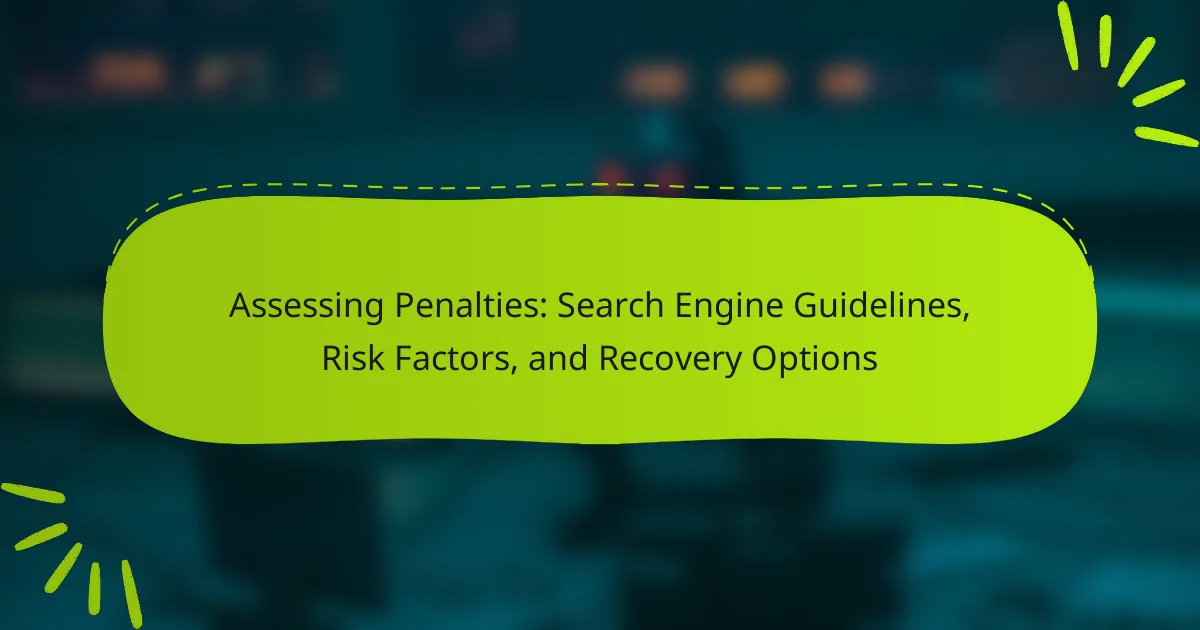Understanding search engine penalties is crucial for maintaining your website’s visibility and performance. Violations of search engine guidelines, such as keyword stuffing or deceptive redirects, can lead to significant consequences, including reduced rankings or complete removal from search results. By identifying risk factors and monitoring for manual action notifications, you can take proactive steps to recover from any penalties and improve your site’s standing.
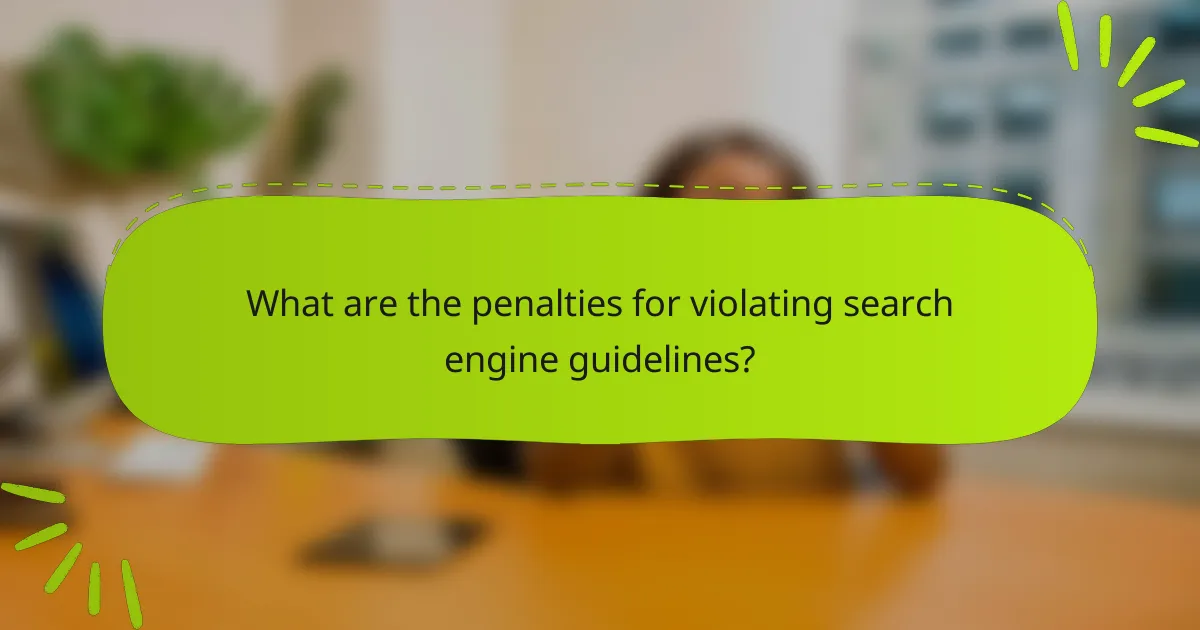
What are the penalties for violating search engine guidelines?
Penalties for violating search engine guidelines can result in reduced visibility or complete removal from search results. These penalties vary by search engine and can stem from practices like keyword stuffing, cloaking, or using deceptive redirects.
Google penalties
Google penalties can be either manual or algorithmic. Manual penalties are imposed by human reviewers when they identify violations, while algorithmic penalties occur automatically through updates like Panda or Penguin. Common issues leading to penalties include low-quality content, unnatural link profiles, and spammy practices.
To recover from a Google penalty, website owners should first identify the cause using tools like Google Search Console. Once the issues are resolved, they can submit a reconsideration request to have the penalty lifted. Regularly monitoring website performance and adhering to Google’s Webmaster Guidelines can help prevent future penalties.
Bing penalties
Bing penalties are less common but can still significantly impact a site’s search ranking. Similar to Google, Bing employs both manual and algorithmic penalties, often targeting practices like keyword stuffing and poor-quality backlinks. The Bing Webmaster Tools can help identify potential issues.
To recover from a Bing penalty, ensure compliance with Bing’s Webmaster Guidelines. Address any identified issues and resubmit the site for review through Bing Webmaster Tools. Maintaining high-quality content and a clean link profile is essential for long-term success.
Yahoo penalties
Yahoo’s search engine operates primarily through partnerships with Bing, meaning penalties often align with Bing’s guidelines. Violations can lead to reduced visibility in Yahoo’s search results, impacting traffic. Common violations include duplicate content and low-quality backlinks.
To recover from a Yahoo penalty, focus on improving content quality and ensuring compliance with Bing’s guidelines, as Yahoo relies on Bing’s algorithms. Regular audits of your website can help identify and rectify issues before they lead to penalties.

How can I identify if my site has been penalized?
To determine if your site has been penalized, look for manual action notifications from search engines and analyze any significant drops in traffic. These indicators can help you pinpoint potential issues affecting your site’s visibility.
Manual action notifications
Manual action notifications are alerts from search engines indicating that your site has violated their guidelines. You can find these notifications in the Google Search Console under the “Security & Manual Actions” section. If you receive one, it will specify the nature of the violation and provide guidance on how to address it.
Common reasons for manual actions include unnatural links, thin content, or spammy behavior. It’s crucial to resolve these issues promptly to restore your site’s standing and visibility in search results.
Traffic drop analysis
Analyzing traffic drops can reveal if your site has been penalized. Use analytics tools to compare traffic patterns over time, focusing on significant declines that coincide with algorithm updates or changes in your site’s content. A drop of more than 20-30% may indicate a potential penalty.
Look for correlations between traffic changes and specific actions, such as content updates or link-building campaigns. If a drop aligns with a known algorithm update, it may suggest your site is affected by a penalty rather than a natural fluctuation in traffic.

What are the common risk factors for penalties?
Common risk factors for search engine penalties include the use of unethical SEO techniques, low-quality content, and manipulative link-building practices. These factors can lead to a decrease in search rankings or even removal from search engine results altogether.
Black hat SEO practices
Black hat SEO practices refer to techniques that violate search engine guidelines to achieve higher rankings. Examples include keyword stuffing, cloaking, and using hidden text. Engaging in these tactics can result in severe penalties, including deindexing from search engines.
To avoid penalties, focus on white hat SEO strategies that prioritize user experience and adhere to search engine guidelines. Regularly review your practices to ensure compliance and avoid shortcuts that could harm your site’s reputation.
Poor quality content
Poor quality content is characterized by thin, irrelevant, or duplicate material that fails to provide value to users. Search engines prioritize high-quality, informative content that engages readers and answers their queries. If your content lacks depth or originality, it may trigger penalties.
To improve content quality, aim for well-researched articles that incorporate relevant keywords naturally. Regularly update existing content to keep it fresh and ensure it meets user needs. Consider using tools to analyze content quality and readability.
Link schemes
Link schemes involve manipulating link-building practices to artificially inflate a site’s authority. This includes buying links, participating in link farms, or excessive reciprocal linking. Such practices are against search engine policies and can lead to penalties.
To build a healthy link profile, focus on earning links organically through high-quality content and genuine outreach. Engage with reputable sites in your niche and avoid shortcuts that could jeopardize your site’s standing in search results.
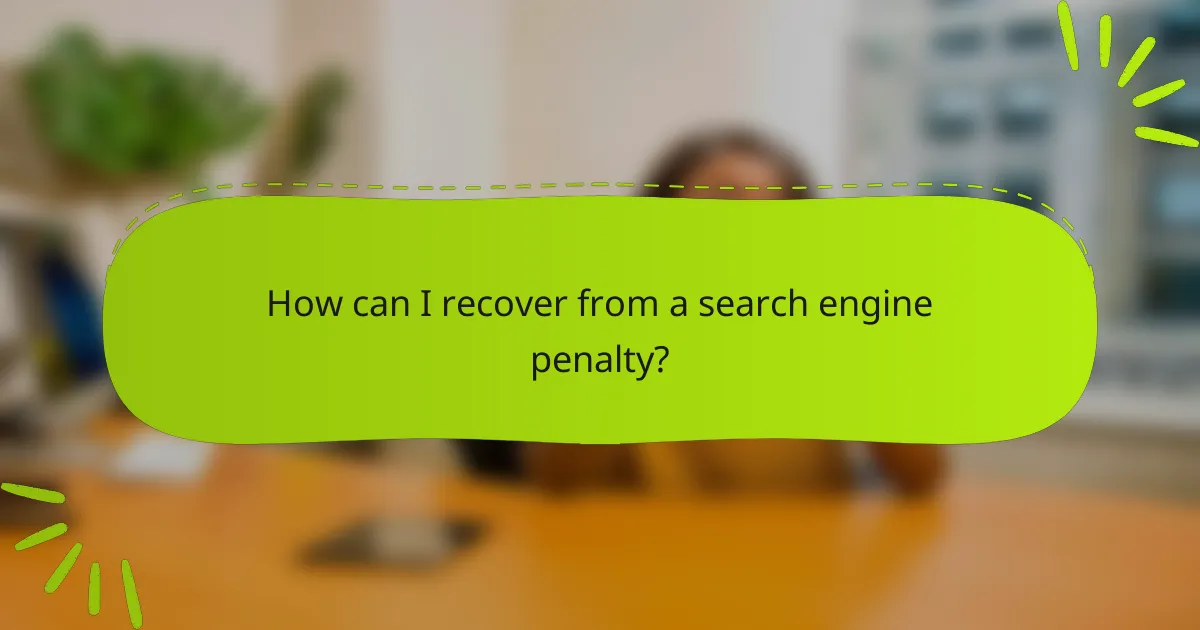
How can I recover from a search engine penalty?
Recovering from a search engine penalty involves identifying the cause of the penalty, addressing the issues, and demonstrating compliance with search engine guidelines. This process can take time and requires a strategic approach to improve your site’s standing.
Submitting a reconsideration request
After addressing the issues that led to the penalty, you can submit a reconsideration request to the search engine. This request should clearly outline the steps you’ve taken to rectify the problems, such as removing harmful content or improving site quality.
Be concise and specific in your request, providing evidence of the changes made. Keep in mind that it may take several weeks for the search engine to review your request and respond.
Improving content quality
Enhancing the quality of your website’s content is crucial for recovery. Focus on creating original, valuable, and relevant content that meets the needs of your audience. This includes using proper grammar, engaging visuals, and ensuring that the information is accurate and up-to-date.
Regularly audit your existing content to identify and update or remove low-quality articles. Aim for content that is comprehensive and well-researched, as this can positively influence your search rankings.
Disavowing toxic backlinks
Toxic backlinks can significantly harm your site’s reputation and lead to penalties. Use tools to analyze your backlink profile and identify links from low-quality or spammy sites. Once identified, you can disavow these links to signal to search engines that you do not endorse them.
To disavow links, create a text file listing the URLs or domains you want to disassociate from your site, and submit it through the search engine’s disavow tool. This process can help improve your site’s credibility and assist in recovery efforts.
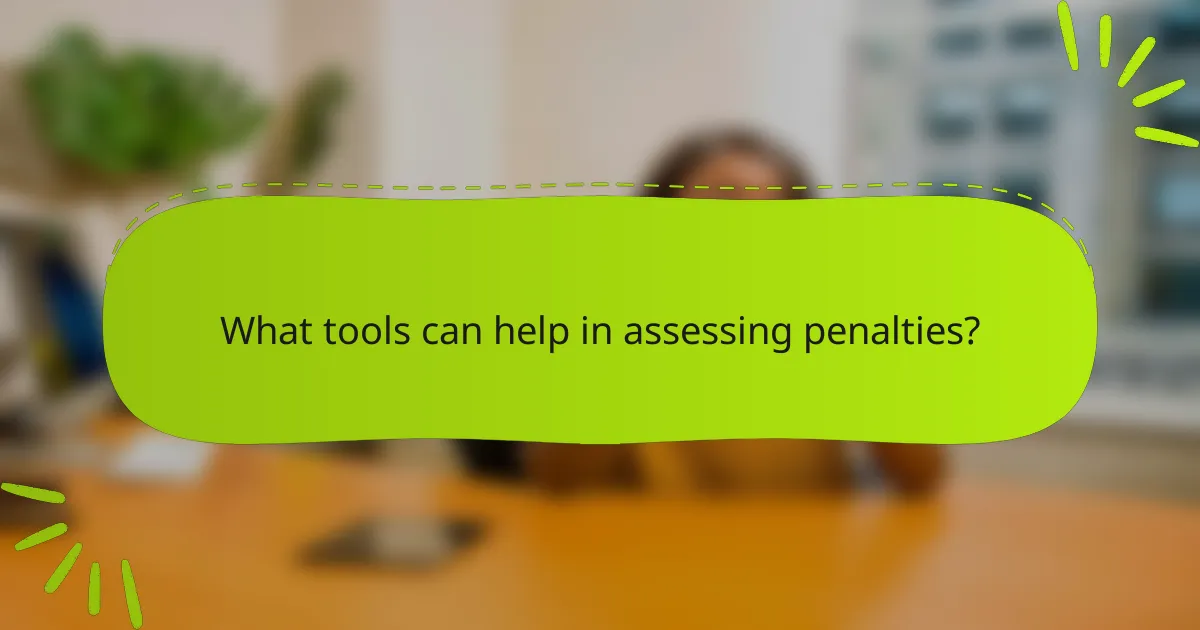
What tools can help in assessing penalties?
Several tools can assist in assessing penalties imposed by search engines, primarily focusing on identifying issues and providing insights into website performance. Utilizing these tools can help diagnose potential penalties and guide recovery efforts effectively.
Google Search Console
Google Search Console is an essential tool for assessing penalties, as it provides direct insights from Google regarding your website’s performance in search results. It alerts you to manual actions taken against your site, which can indicate penalties.
To use Google Search Console effectively, regularly check the “Security & Manual Actions” section for any notifications. Additionally, monitor your site’s performance metrics to identify sudden drops in traffic that could signal a penalty.
SEMrush
SEMrush offers a comprehensive suite of tools for SEO analysis, including features that help assess penalties. Its “Domain Analytics” section allows you to track changes in organic traffic and keyword rankings, which can reveal the impact of potential penalties.
Utilize the “Traffic Analysis” feature to compare your site’s performance against competitors. This can help identify if a drop in traffic is due to penalties or other factors. Regular audits with SEMrush can also uncover technical issues that may lead to penalties.
Ahrefs
Ahrefs is another powerful tool for assessing penalties, particularly through its backlink analysis capabilities. A sudden increase in toxic backlinks can indicate a risk of penalties, and Ahrefs helps identify these harmful links.
Use the “Site Explorer” feature to analyze your backlink profile and monitor for any unusual spikes or drops in referring domains. Regularly auditing your backlinks can help you take proactive measures to disavow harmful links before they lead to penalties.
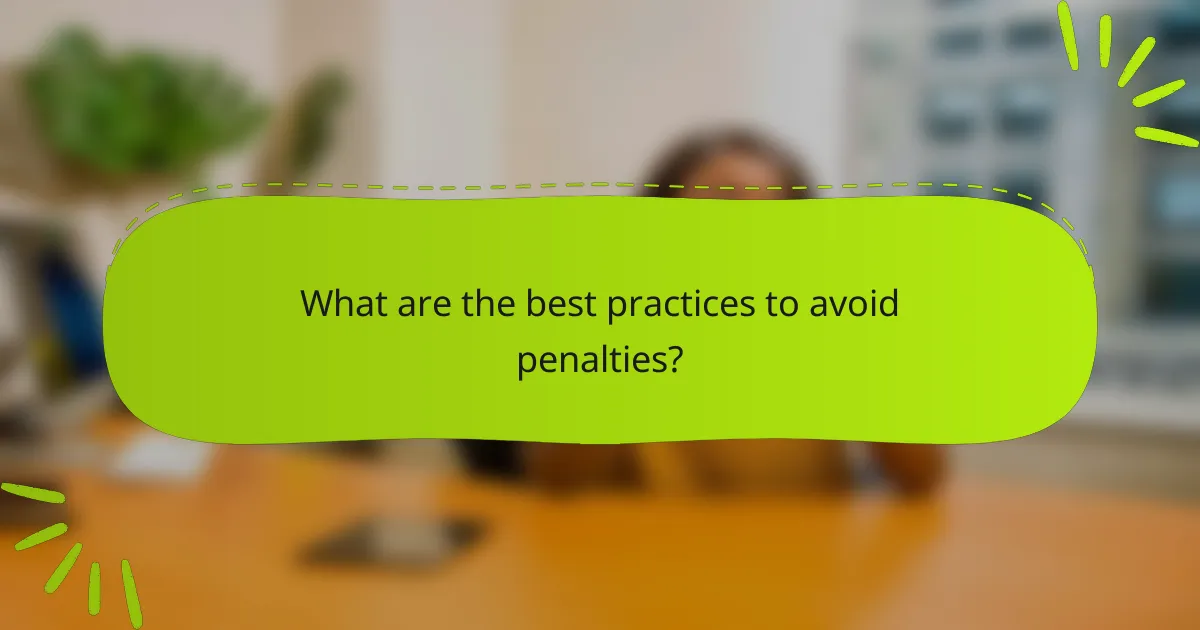
What are the best practices to avoid penalties?
To avoid penalties from search engines, adhere to established guidelines, conduct regular audits, and stay informed about algorithm updates. Implementing these best practices can significantly reduce the risk of being penalized for non-compliance.
Adhering to guidelines
Following search engine guidelines is crucial for maintaining a healthy website. Familiarize yourself with the specific rules set by major search engines like Google and Bing, which include avoiding deceptive practices such as keyword stuffing and cloaking.
Regularly review and update your content to ensure it aligns with these guidelines. For example, focus on creating high-quality, original content that provides value to users, as this is a key factor in search engine rankings.
Regular site audits
Conducting regular site audits helps identify potential issues that could lead to penalties. These audits should include checks for broken links, duplicate content, and compliance with mobile-friendliness standards.
Utilize tools like Google Search Console or third-party SEO software to monitor your site’s performance. Set a schedule for audits, such as quarterly, to ensure ongoing compliance and to address any emerging issues promptly.
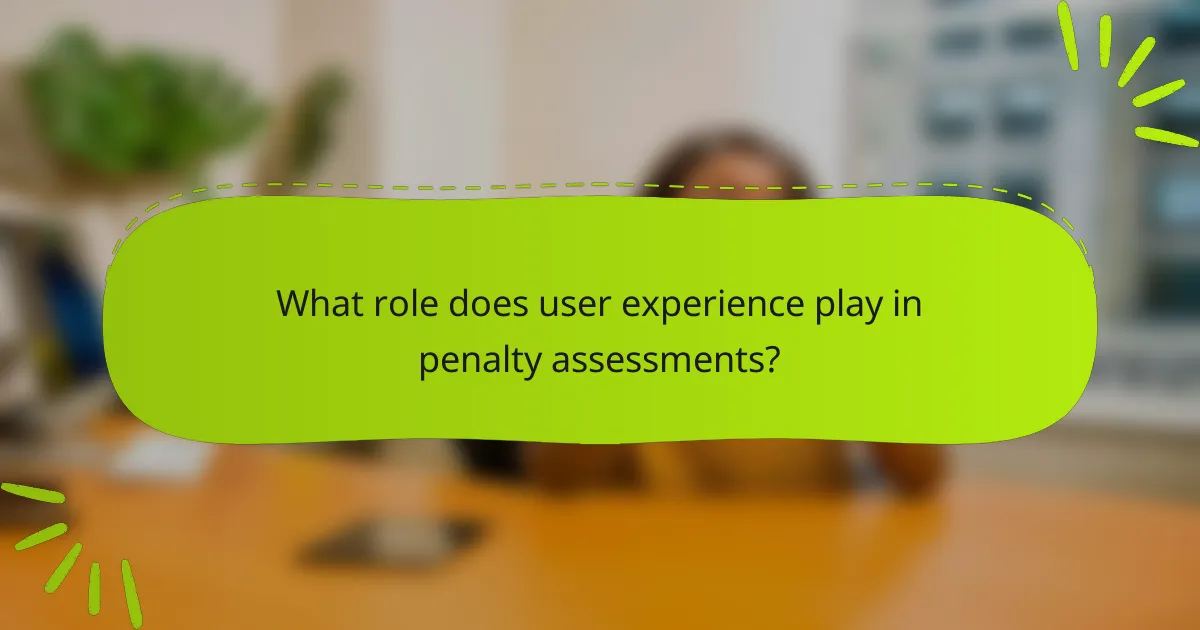
What role does user experience play in penalty assessments?
User experience is crucial in penalty assessments as search engines prioritize sites that provide a positive and engaging experience for users. Poor user experience can lead to penalties, affecting a site’s visibility and ranking in search results.
Understanding user experience metrics
User experience metrics include factors such as page load speed, mobile responsiveness, and overall site usability. Search engines analyze these metrics to determine how effectively a site meets user needs. For instance, a site that loads slowly may frustrate users, leading to higher bounce rates and lower rankings.
Impact of user engagement on penalties
User engagement metrics, such as click-through rates and time spent on site, directly influence penalty assessments. A high bounce rate can signal to search engines that users are dissatisfied, potentially resulting in penalties. Maintaining user engagement through quality content and intuitive design is essential for avoiding these issues.
Improving user experience to mitigate risks
To enhance user experience and reduce the risk of penalties, focus on optimizing site speed, ensuring mobile compatibility, and simplifying navigation. Regularly testing your site’s performance and gathering user feedback can help identify areas for improvement. Implementing these changes can lead to better engagement and lower chances of incurring penalties.
